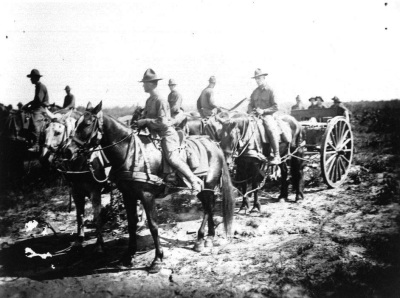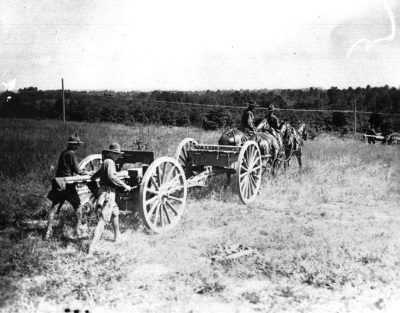1917-1918
Kentuckians Patrol the Border & See First Military Aircraft


138th Field Artillery Regiment training at Ft. Knox with the French 75 MM Gun, this was prior to their overseas deployment for the First World War
The threat of the entrance of the United States into World War I precipitated much military activity during the early part of April 1917. The passage of the Selective Service Act of 1917, which initiated the draft, froze volunteer recruiting for both the Regulars and the Guard. But meanwhile, a high-pressure recruiting campaign had swollen the Guard ranks to such an extent that it was able to field seventeen of the forty-two infantry divisions plus part of the personnel of the forty-five squadrons of the Army Air Corps and all other non-divisional components that also crossed the water to make up Pershing's well-rounded American Expeditionary Force. The Kentucky Adjutant General reported that, at a meeting of the National Guard Association, the delegates had heartily favored Federalization of various states' National Guards. Kentucky's recruiting was rapidly bringing the Guard up to its maximum peacetime strength. In April the National Guard, with the exception of those Guardsmen who had dependents, was ordered to begin mobilizing at Camp Stanley. Camp Stanley was about three miles out of Lexington on Versailles Road.
The Kentucky Brigade was moved to Camp Shelby, Mississippi, to join the 38th Regular Army Division. The Division had been organized in August 1917 from other National Guard groups of Kentucky, West Virginia and Indiana. This Division was designated as replacements, and in May of 1918 only the official skeleton of the 38th Division continued at the camp. Everyone else had been shipped overseas. Upon arrival in France, the 38th Division was sent to the LeMans area where it continued as a replacement division.
Kentucky units soon lost their identity, having been merged with other troops in various divisions, the chief of which were the First, Second, Third and Fourth of the 42nd Division. This later unit, known as the Rainbow Division, was composed of the National Guard of Kentucky and 25 other states. Activities of the Kentucky troops are contained in a brief report by General Pershing to the Secretary of War. General Pershing's report said that at Marshall Foch's request the First Division was transferred from the Toul Sector to Chaumont on Vexin and shortly after, on April 26, 1918, the Division went into the line on the Picardy battlefront. The Second Division, having been held in reserve near Montididier, was sent to check the progress of the Germans toward Paris. The Rainbow Division was on the line east of Rheims, where it held its position unflinchingly. The Third Division held the bank of the Marne opposite Chateau Thierry. A single regiment of the Third prevented the advance of the Germans. The Germans had gained a position that compelled this regiment to open fire in three directions, thereby repulsing the German troops, 600 of, which were taken prisoner. During July the Third Division made its way into Roncheres Wood and was relieved. The Rainbow Division captured Sergy, whereupon it was relieved. Kentucky troops fought in the front ranks in all of these engagements, which terminated in the reduction of the Marne Salient.
In August the American Army under General Pershing took over the battle front from St. Michael to Verdun. On September 12 an attack was begun by the seven American divisions, which terminated in repulsing the salient commanded by the German Crown Prince. Thereupon the Americans turned toward Metz and Sedou. In the Battle of St. Michael, the Second, Third and Forty-second Divisions played a leading part, the First Division having been held in reserve. At the time of the Armistice, Kentucky troops were in advance to the American Army toward Sedou.
Insert Medal Here
Records of the United States War Department best show Kentucky's participation in World War I. A total of 84,172 persons from Kentucky served in the United States Army. This total included 80,009 enlisted men, 3,747 commissioned officers, 241 nurses, 153 army field clerks, and 22 United States Marine Cadets. A breakdown of these figures show that there were 12,759 men in the regular Army, 7,518 National Guardsmen, 2,526 in the Reserve Corps, 2,734 volunteers, and 58,635 drafted men. Seven Kentuckians were Army Major Generals, nine were Brigadier Generals, and 23 were Colonels. Distinguished aviators were Major Victor Strohm and Lieutenant Colonel J. O. Creech. Of the overall total 41,655 saw overseas duty, while 2,418 deaths occurred among Kentucky troops, 890 of which were battle deaths.
Two men with Kentucky backgrounds were awarded the Medal of Honor, Captain Samuel Woodfall and Sergeant Willie Sandlin. When General Pershing was asked to name the most gallant among all of America's heroes of the Great War, Captain Woodfall, resident of Fort Thomas, Kentucky, was among his selections. Sergeant Sandlin was a native from Buckhorn, Kentucky. In 2000, the family of Willie Sandlin donated his Medal of Honor to the Kentucky Military History Museum.
Denhardt Recruiting Broadside

Denhardt Recruiting Broadside
In 1917 Major Henry H. Denhardt called for a World War I recruitment rally to be held at the Warren County fairgrounds in Bowling Green. Accompanied by a band and soldiers, Denhardt was to explain "the advantages of their enlisting now."
Denhardt went on to serve as Lt. Governor and as Adjutant General.
Used with the permission of the Kentucky Library & Museum, Western Kentucky University.
Additional Resources